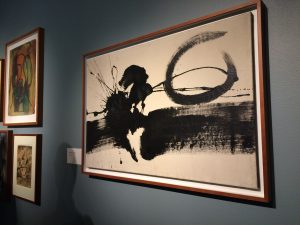Tacoma Art & History Museums Field Trip
First Exhibit: Takuichi Fujii
- Main Thoughts:
- 400 pg. visual diary of Minidoka Internment experience
- from Hiroshima – How did he feel when the bomb was dropped?
- use of vivid colors, visceral scenes, abstraction
- I like that his piece titles = non-existent/entire quotes
- good example of art made out of scarce resources
- his art is beautiful, impactful enough to be in a larger gallery
- hindered by being Japanese
- ironic b/c exhibit that’s making him more known is on internment
- Who decides what is “classic”?
- “A fight between bird and snake” painting = metaphor
- Japanese – seen as dangerous snakes
- American gov. – birds surrounding
- “Words Matter”
- similar theme throughout Otsuka’s When the Emperor was Divine
- the rhetoric that shaped people’s beliefs
- ex: “Loyalty. Disloyalty. Allegiance. Obedience… ‘Words,’ she said, ‘it’s all just words.'” (99)

Second Exhibit: Zhi Lin
- Main Thoughts:
- making Chinese railroad workers visible, yet intentionally ambiguous
- use of traditional Chinese colors and paper
- below celebratory photo which omits them are hundreds of rocks with Chinese names on them
- placed himself and places audience in their shoes
- how much research was involved
- Invisible and Unwelcomed People – exclusion of Chinese in Tacoma specifically
- Reconciliation Park

Pop Culture Murkiness
- Highlights:
- disagreement on common term definitions
- pop culture = confusing, messy, “melting pot” – Tony Bennett
- culture = “ensemble of stories that we tell ourselves about ourselves” – Clifford Geertz
- problematic definitions
- no “pure” pop culture, always cross-influence & hybrid
- Boundaries? Origin of “APIA” term?
- embrace “splendid messiness” & process of working through it
Writing Workshop
- Main Points:
- story = continuum
- narration = how you tell story through your voice
- text = writing end result
- creative essay is not the 5 paragraph essay!
- stay authentic, “It is myself I portray” – Montaigne
- employ writer’s toolbox
- How do you remain creative within a rhetorical process?
Things to Remember:
- Don’t overthink it – enjoy the process
- acknowledge individual writing process and tools
- revision is key, nothing is ever perfect
Film and Seminar Notes
- History and Memory – Rea Tajiri
- Who chose/was allowed to tell what story?
- being seen out of focus evolved into being seen with a sharp outline
- disjointed construction of documentary = spotty history of Japanese internment
- Rabbit in the Moon – Emiko Omori
- pareidolia: reality vs. illusion
- Prosthetic Memory – Alison Lansberg
- PTSD (indiv. and collective)
- Poston camp was on Native reservation land, built on w/ no permission
- rhetoric: “concentration/internment/relocation camp”
2. When the Emperor was Divine – Julie Otsuka
- annotation “map/web”
- internment camps made of Japanese & Japanese Am.s
- Nisei Daughter – Monica Sone
- experience of diff. generations
Themes:
- use of dreams and memories to convey emotion
- reaching for “normality” = never attainable, something they’re not worthy of
- religion, resurrection
- tortoise symbolism: spring, hope, freedom crushed beneath whiteness
- psychological manipulation so Japanese blamed selves
- ex: always apologizing, mother and pearl, girl and jumprope
- “we” in last chapter – unification, “all the same”
- Japanese resilience through ability to grow despite imprisonment
- ex: farming, bringing water back to camp
- whiteness as it interacts w/ classism
- rich white vs. “Okie” white
- always trying to prove whiteness/Americanness to survive – Ozawa case
- significance of rhetoric
- internalized self-hatred
- choose a side, either/or binary
- model minority, interracial tensions pushed b/c of expectation to attain whiteness – in order to do that, be “better” than “lesser” minorities/poc
- What happens when someone is multi-racial/ethnic, living in both worlds
- how you identify internally vs. externally & how one gets treated b/c of those
- whiteness as recurring symbols throughout book
- ex: white dust, white gloves, white dog, white horses
- consistent juxtapositions/conflict
- American/white vs. Japanese
- life before vs. after war
- hero vs. enemy
- hope, innocence vs. loss of hope, innocence
- last chapter: “Confessions”
